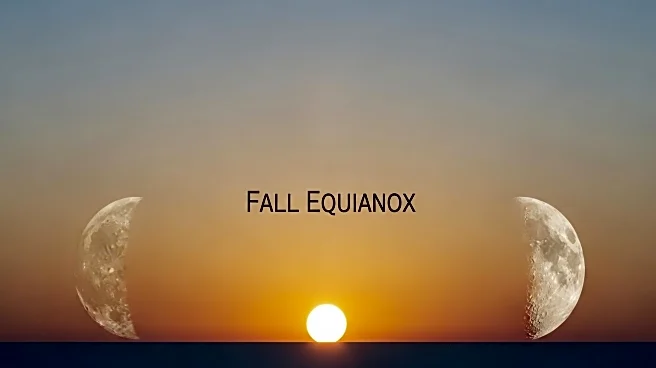What's Happening?
The autumn equinox has arrived, marking the beginning of astronomical autumn in the northern hemisphere. On September 22, 2025, at 2:20 p.m. EDT, the sun crossed the celestial equator, an imaginary line that divides the northern and southern celestial hemispheres. This event occurs due to Earth's 23.5° axial tilt, which affects the sun's apparent path in the sky as the planet orbits the sun. Equinoxes happen twice a year, in March and September, when the sun shines equally on both hemispheres, resulting in roughly equal day and night durations. The term 'equinox' is derived from Latin, meaning 'equal night.' As the sun rises due east and sets due west, the northern hemisphere will experience cooler temperatures and longer nights until the winter solstice on December 21.
Why It's Important?
The autumnal equinox is significant as it signals a shift in seasons, impacting various aspects of life in the northern hemisphere. Longer nights provide ideal conditions for stargazing and astronomy enthusiasts, who can take advantage of the darker skies. This seasonal change also affects agriculture, as farmers prepare for harvests and adjust to cooler temperatures. Additionally, the equinox influences cultural and religious events, with many societies celebrating the transition to autumn. The equinox serves as a reminder of Earth's natural cycles and the interconnectedness of celestial movements with daily life.
What's Next?
Following the autumnal equinox, the northern hemisphere will continue to experience longer nights and cooler temperatures. This period is ideal for stargazing, and enthusiasts are encouraged to explore the skies using telescopes and binoculars. As the season progresses, the moon will rise higher in the night sky, offering opportunities for astrophotography. The changing weather will also prompt adjustments in agricultural practices and preparations for winter. Cultural celebrations related to the equinox may continue, highlighting the importance of seasonal transitions in various communities.
Beyond the Headlines
The autumnal equinox not only marks a change in season but also reflects deeper cultural and scientific implications. It underscores the importance of understanding Earth's axial tilt and its effects on climate and daylight. The equinox is a time for reflection on the balance between light and darkness, often symbolizing renewal and change in various traditions. It also highlights the role of astronomy in connecting people to the universe, encouraging exploration and appreciation of celestial phenomena.











